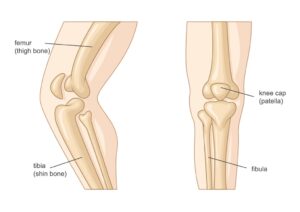January 13, 2021
Anatomy Lesson: The Legs, Our Base for Support & Motion
By Leslie LaPlace
As part of our ongoing anatomy series, we move from the foot and ankle (our foundation for balance) to look at the leg. Some of what follows you might remember from high school or college biology classes, and we will go into some detail. We hope you find this series informative and useful in ways that help you get a better understanding of the importance of fitness and exercise for maintaining an active life and optimal mobility whatever your age.
Fun fact: the Encyclopedia Britannica defines the leg as the “limb or appendage of an animal, used to support the body, provide locomotion, and, in modified form, assist in capturing and eating prey”.
Given that we human animals mostly enjoy farmed food and eat with our hands, this article will focus on how the legs’ structure supports the body and helps us move. We’ll go into some details related to the bones and muscles in the legs. And we close the article with some exercises and stretches.
Let’s get through the anatomy lesson first, shall we?!
Basic Skeletal Leg Structure

Our legs – with their bones, muscles and joints – have to work together to help us stand, walk, run and jump while also supporting our weight and maintaining balance. That’s a big job, so how do they do it?
It starts with a strong structure. Human legs are comprised of several strong bones and joints that connect to provide a solid foundation for the body. Starting at the top of the leg, the hip joint connects the pelvis to the thigh bone (femur). The largest, longest, strongest bone in the body, the thigh bone can support up to 30 times the weight of the body. At its top end, it helps create the hip joint, and at its lower end, it forms a part of the knee joint. The rest of the leg bones aren’t as big as the femur, but they each play important roles.
The kneecap (patella) is the front of the knee joint. It helps the knee to extend. It also protects the knee joint from damage. The second longest bone in the body, the shinbone (tibia) connects to the knee at its top and to the ankle at its bottom. On the outside of the lower leg, the calf bone (fibula) is connected to both ends of the shinbone by ligaments. The shinbone supports the body’s weight in the lower leg, while the calf bone is primarily responsible for supporting the muscles that help you balance in the lower leg and ankle.
Basic Leg Musculature: The Upper Leg
There are numerous muscles in the legs. We are going stick to the major muscles that support the functions of the legs. Even just covering these major muscles, you will begin to understand how complex our leg structure is.
The front of the thigh is made up of the Sartorius and the quadriceps femoris. As you might expect based on what we know of the thigh bone, the Sartorius is the body’s longest muscle. It stretches from the pelvis to the shinbone, starting on the outside of the pelvis and crossing over the thigh. Its main function is to help us flex (bend) and extend (straighten) the hip and the knee.
The Quadriceps Femoris is actually composed of four muscles: three deep-lying vastus muscles are covered by a fourth muscle, the rectus femoris. The vastus muscles start at the thigh bone and attach at the kneecap. The rectus femoris starts at the pelvis and also attaches to the kneecap. These four muscles help us bend and extend our lower leg at the knee joint and also stabilize and protect our kneecap.
The back of the thigh has three key muscles, which we often call the hamstrings. They are the biceps femoris, semitendinosus and semimembranosus. They all start at the pelvis and then attach to the lower leg bones. These muscles extend the hip and bend the lower leg at the knee.
Basic Leg Musculature: The Lower Leg
Muscles that generate movement at the ankle are generally found in the lower leg. They can be split into three categories: anterior compartment, posterior compartment and lateral compartment.
In the Anterior (front) Compartment, three muscles in the lower leg help rotate the foot at the ankle joint and extend the toes. These muscles all start at the shinbone and attach to the toes. The strongest muscle in the shin, the Tibialis Anterior, sits to the side of the shinbone. The shinbone itself has little muscle to cushion it, which is why it’s so painful when you hit your shin against something.
In the Posterior (back) Compartment, several muscles are located in the back of the lower leg – some superficial and others deep. The most commonly known are the two superficial muscles (gastrocnemius and soleus) that make up the characteristic shape of the lower leg or calf. They help bend the foot so that we point our toes.
In the Lateral Compartment, two muscles function to control eversion (tilting of the sole away from the body). Our feet have a tendency to invert (sole in) so these muscles also prevent excessive inversion.
Basic Leg Musculature: The Adductor Muscles
Did we mention that there are even more leg muscles than what we’re covering in this particle? Our final group of muscles for the legs are the adductors, which consist of five muscles.
These muscles are responsible for adduction of the thigh (bringing the thigh across the front of the body) along with other functions. Four of them – longus, magnus, brevis and obturator externus (sounds like a team of superheroes!) – start at the pubis and attach to the bottom of the thigh bone. In addition to adduction, they also act to rotate and extend the thigh. The fifth muscle, the gracilis, starts at the pubis and attaches at the shinbone, crossing both the hip and knee joints. It helps to move the hip and knee.
The Knee Joint: Crossroads of Bones & Muscle
Finally, we come to the crossroads of the upper and lower leg: the knee joint. It is both the largest and the most important joint in the body.
The knee joint uses muscles and ligaments to withstand the torques and strains of powerful leg movements. Between the thigh bone and shin bone is the meniscus, a layer of tough fibrocartilage that acts as a shock absorber.
The knee allows the lower leg to move relative to the thigh while supporting the body’s weight. It is essential to daily activities such as walking, running, sitting and standing. It is created by three bones: the thigh bone (femur), shin bone (tibia) and kneecap (patella). At the center is the kneecap, which helps extend the knee and protect the joint. As the knee bends, the kneecap slides along a groove in the thigh bone.
The knee joint is actually comprised of two joints. The tibiofemoral joint is between the thigh bone (femur) and shin (tibia) and is the weight-bearing knee joint. The patellofemoral joint joins the kneecap with the thigh bone.
The tibiofemoral joint is relatively weak and easily damaged, so it relies on muscles and ligaments to ensure stability. When the knee is fully extended, the thigh bone rotates slightly on the shin bone to lock the joint into place, allowing for efficient load bearing.
The patellofemoral joint has two key functions: improve muscle stability and protect the knee joint from damage.
There are three sets of muscles that allow for movement, balance, and stability at the knee joint. Two we’ve already discussed above – the quadriceps femoris and the hamstrings. The third is the popliteus, a muscle located behind the knee which “unlocks” the fully extended knee joint and allows for flexion. At full extension, the shin and thigh bones “lock” into position, providing stability in the leg and improving load-bearing capacity.
How the Leg Muscles Work Together for Movement
Muscles move body parts by contracting and relaxing. Muscles can only pull bones (not push them), so they need an opposite (antagonist) muscle to pull it back to its original position. So, muscles work in pairs of flexors and extensors (antagonist pairs).
The flexor contracts to bend a limb at a joint. Then, the extensor contracts to extend or straighten the limb at the same joint. For example, to walk, you have to alternately bend and straighten the leg, so the quadriceps (front) and the hamstrings (back) work together to move your leg. When you straighten your leg, the quads contract and the hamstrings relax. When you bend your leg, the hamstring muscles contract and the quads relax.
In the lower leg, the tibialis anterior and the gastrocnemius work together to move the foot at the ankle joint. The tibialis anterior contracts to flex your foot while the gastrocnemius relaxes and the opposite happens when you point your foot.
So you can see why it’s important to have a good strength training program. If one muscle group is stronger than the other, it can also change the natural range of motion of the joint. Making sure each muscle pair is strong will help reduce the risk of injury and is essential to good posture.
Exercises & Stretches for the Legs
So, what are some of the exercises you can do to help strengthen your legs? To make it easier, I’ve created a video on You Tube that will walk you through some basic exercises. Remember, when you’re legs are strong, you can better retain your independence and continue to do the things you want to do.
______________________
Leslie LaPlace, Fitness Manager at Goodwin House Alexandria, is self described recovering Software Development Project Manager. Leslie parlayed a lifelong love of and belief in the restorative power of exercise into a satisfying career working with adults ages 55 and older. She believes that staying active can help reduce aches and pains—It’s also a great anti-aging remedy. She has more than six years’ experience working with seniors at Arlington County, The Jefferson, Goodwin House Bailey’s Crossroads and Goodwin House Alexandria. Leslie is a certified personal trainer and aquatic instructor who loves creating a positive and fun training experience. She believes that it’s never too late to improve your strength and balance!





